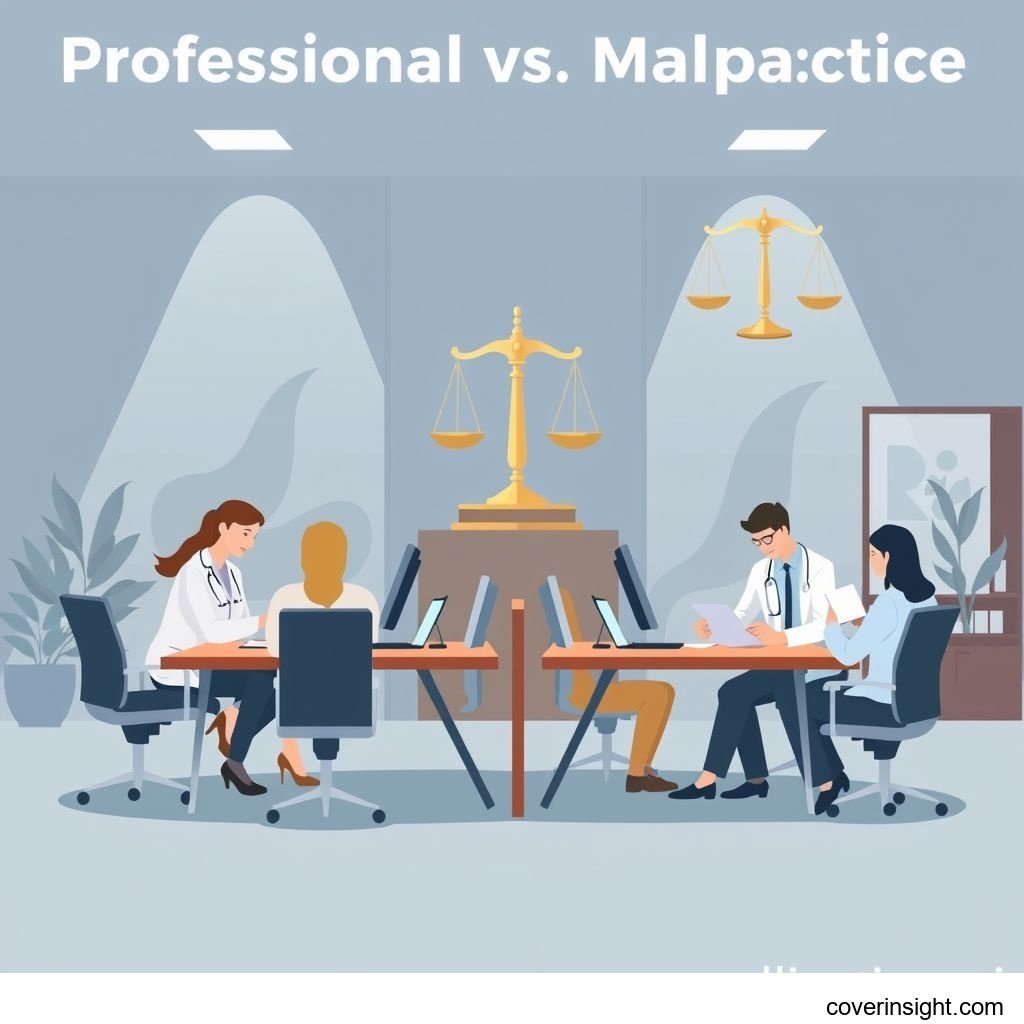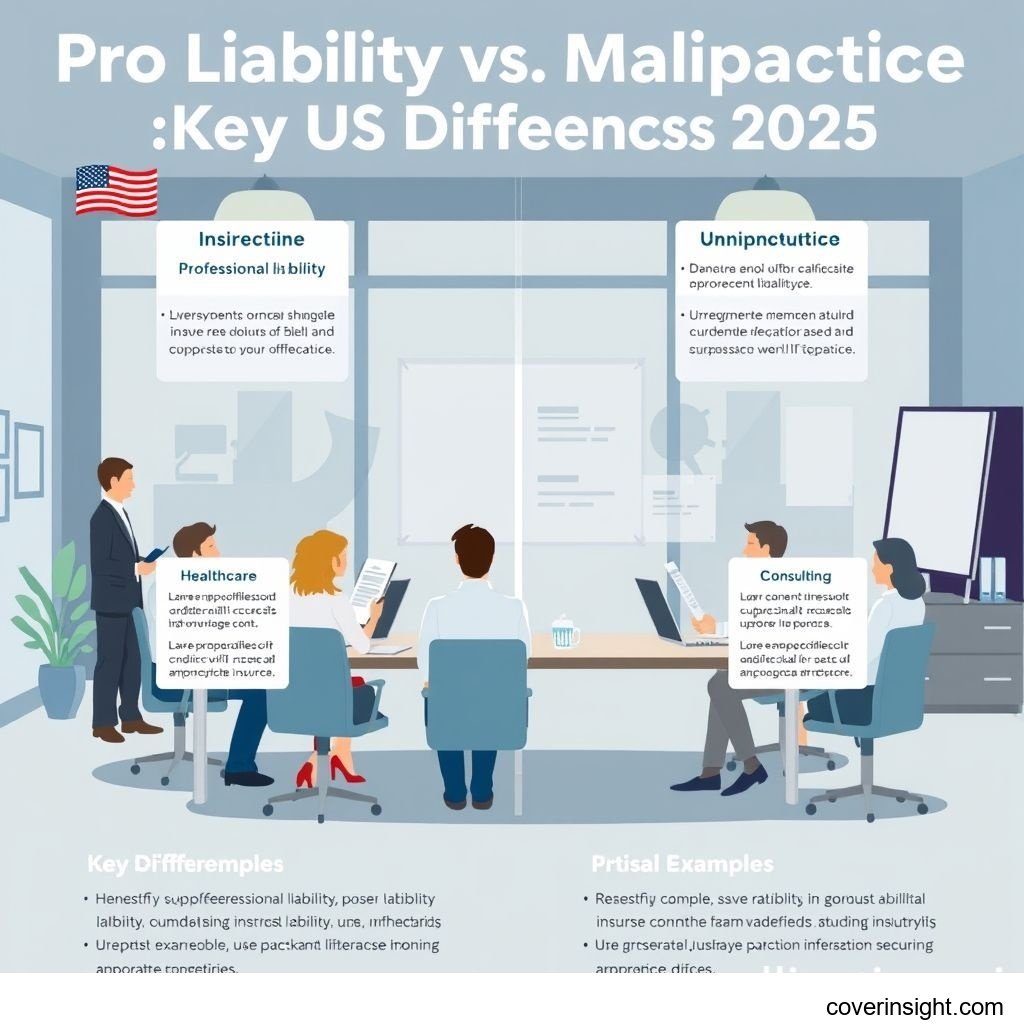Introduction
Navigating the complex world of insurance can feel like trying to solve a Rubik's Cube blindfolded, especially when distinguishing between professional liability and malpractice insurance in the US for 2025. While often used interchangeably, these two vital forms of coverage serve distinct, yet equally critical, purposes in protecting professionals and their businesses. Understanding their nuances isn't just about ticking a box; it's about safeguarding your career, your financial stability, and your peace of mind in an increasingly litigious landscape. From doctors and lawyers to consultants and tech professionals, securing the right coverage is no longer an option—it's an absolute necessity.
Coverage Details
What’s Included
Professional liability insurance, often dubbed "Errors & Omissions" (E&O) insurance, is designed to protect businesses and individuals from claims of negligence, errors, or omissions in their professional services. Think of it as a safety net for those who offer advice, design solutions, or provide expert services. For example, if a marketing consultant provides advice that leads to significant financial losses for their client, professional liability insurance could cover the legal defense costs and any damages awarded. This coverage typically extends to allegations of misrepresentation, violation of good faith and fair dealing, and inaccurate advice. It's truly a must-have for architects, IT professionals, real estate agents, and even graphic designers.
Malpractice insurance, on the other hand, is a specific type of professional liability coverage tailored for the medical and healthcare fields. It addresses claims arising from bodily injury or property damage due to a professional's alleged negligence, misdiagnosis, surgical errors, or inappropriate treatment. Consider the unfortunate case reported by the National Practitioner Data Bank (NPDB), which consistently logs tens of thousands of adverse actions and payments due to medical malpractice in the US annually. For healthcare providers, this isn't just about reputation; it’s about covering potentially astronomical legal fees and settlements that could arise from patient harm. Both types of policies typically cover defense costs, settlements, and judgments, even if the claim proves to be baseless, preventing a lawsuit from sinking your entire operation.
Common Exclusions
While robust, both professional liability and malpractice insurance come with exclusions that are important to note. Generally, neither policy covers claims arising from:
-
Intentional criminal acts or fraud: If you knowingly commit a crime or engage in fraudulent activities, your policy won't bail you out.
-
Bodily injury or property damage (unless specific to malpractice): General professional liability policies don't cover these; that's typically the domain of general liability insurance. However, malpractice insurance does specifically cover bodily injury resulting from professional negligence.
-
Breach of contract: While related to professional services, a simple failure to deliver on a contractual agreement without an error or omission in professional duty might not be covered.
-
Employee injuries: This falls under Workers' Compensation.
-
Patent or copyright infringement: This might require a specialized intellectual property policy.
-
Claims occurring before the policy's retroactive date: Most policies have a "retroactive date," meaning they won't cover incidents that happened before that date, even if the claim is filed during the policy period.
It’s always prudent to read the fine print or check with your provider to avoid any unwelcome surprises, much like finding a hidden clause in a lease agreement. For a broader perspective on various coverage types, you might want to explore our Insurance Resources Global page.
Cost Analysis
Price Factors
The cost of professional liability vs malpractice insurance is far from a one-size-fits-all scenario; it's highly individualized, akin to how your car insurance premium is calculated. Several factors play a significant role:
-
Profession and Industry Risk: A neurosurgeon, for instance, faces substantially higher malpractice premiums than a freelance graphic designer's professional liability premium. The inherent risk associated with potential errors in each field is a primary driver. Highly regulated industries or those involving direct client health and safety will naturally command higher rates.
-
Claims History: A pristine claims record can lead to lower premiums, while a history of past claims will likely result in higher costs. It’s a bit like having a clean driving record.
-
Coverage Limits and Deductibles: Opting for higher coverage limits (the maximum the insurer will pay out) will increase your premium, while choosing a higher deductible (what you pay out-of-pocket before insurance kicks in) can lower it.
-
Geographic Location: Insurance costs can vary by state or even by specific regions within a state, influenced by local litigation trends and regulatory environments. According to recent data from state insurance departments, medical malpractice premiums can differ by hundreds of thousands of dollars annually across states due to varying tort laws and claim frequencies.
-
Business Size and Revenue: Larger companies with more employees and higher revenue often face higher premiums, as they present a greater potential for liability.
-
Risk Management Practices: Demonstrating robust risk management protocols, ongoing professional training, and adherence to best practices can sometimes lead to discounts.
Saving Tips
While you can't control the inherent risk of your profession, there are smart strategies to keep your premiums in check:
-
Shop Around: Don't settle for the first quote. Get multiple quotes from different providers. The market is competitive, and prices can vary widely for similar coverage.
-
Increase Your Deductible: If you have a solid emergency fund, opting for a higher deductible can significantly lower your annual premium. Just be sure you can comfortably cover that deductible if a claim arises.
-
Bundle Policies: Many insurers offer discounts if you bundle professional liability or malpractice with other policies like general liability or business owner's policies (BOPs).
-
Implement Strong Risk Management: Actively mitigate risks in your practice. This could mean thorough client onboarding, clear contracts, regular training, and comprehensive record-keeping. Some insurers offer discounts for proactive risk management.
-
Maintain a Clean Claims History: This goes without saying. Avoiding claims is the best way to keep your premiums low over the long term.
-
Join Professional Associations: Some professional organizations offer group discounts on insurance for their members.
For personalized guidance and to explore various options, checking out resources like the National Association of Insurance Commissioners can be incredibly helpful for understanding state-specific regulations and consumer guides.
FAQs
How much does professional liability vs malpractice cost?
The cost varies wildly. Professional liability for a low-risk professional like a freelance writer might start from a few hundred dollars per year. For a high-risk IT consultant or engineer, it could range from $1,000 to several thousands annually. Malpractice insurance is significantly more expensive, particularly for high-risk specialities. A general practitioner might pay $5,000-$15,000 annually, while a surgeon or obstetrician could easily pay upwards of $50,000 to $200,000+ per year, depending on the state and specialty.
What affects premiums?
As discussed under "Price Factors," key elements include your profession's inherent risk, your claims history, the coverage limits and deductible you choose, your geographical location, and the size and revenue of your business. Your risk management practices can also play a role.
Is it mandatory?
In many professions, particularly healthcare, malpractice insurance is legally mandatory at the state level. For other professionals, professional liability insurance is often not legally mandated but is almost universally required by clients or industry best practices. For instance, many contracts with corporate clients will stipulate that a consultant must carry a certain amount of E&O coverage. While not mandated by law, operating without it would be like walking a tightrope without a net—it’s an unnecessary risk. Information on specific state requirements can often be found on State Insurance Departments websites.
How to choose?
Choosing the right policy involves assessing your specific risks, understanding your client contracts, and comparing quotes from reputable insurers. Look beyond just the price; consider the insurer's reputation, financial stability, claims handling process, and customer service. Reading policy language carefully to understand what is included and, crucially, what is excluded, is paramount. You might also consult with an independent insurance broker who specializes in your industry. For those in healthcare, resources like Healthcare.gov can offer general insights, though specific malpractice insurance guidance often comes from industry-specific brokers. For comprehensive US-specific insurance guidance, our US Insurance Home page is a good starting point.
Consequences of no coverage?
Operating without professional liability or malpractice insurance can have catastrophic consequences. If a client or patient sues you for an error or negligence, you would be personally responsible for all legal defense costs, settlements, and judgments. This could mean draining your personal savings, liquidating assets, or even facing bankruptcy. In healthcare, it could also lead to losing your license to practice. It’s truly not worth the gamble; the peace of mind alone is worth the investment.
Author Insight & Experience:
Based on my experience living and working within the US professional landscape, the distinction between professional liability and malpractice insurance, while seemingly semantic to some, is profoundly practical. I've observed firsthand how even a seemingly minor oversight can snowball into a significant legal challenge for small businesses and independent professionals. It's not just about protecting against blatant errors, but also about guarding against misinterpretations or unforeseen consequences of advice given in good faith. In a society where litigation is often a first resort, having the right insurance isn't merely a business expense; it's a strategic investment in longevity and resilience. You wouldn't drive without car insurance, so why practice your profession without adequate protection?








Comments